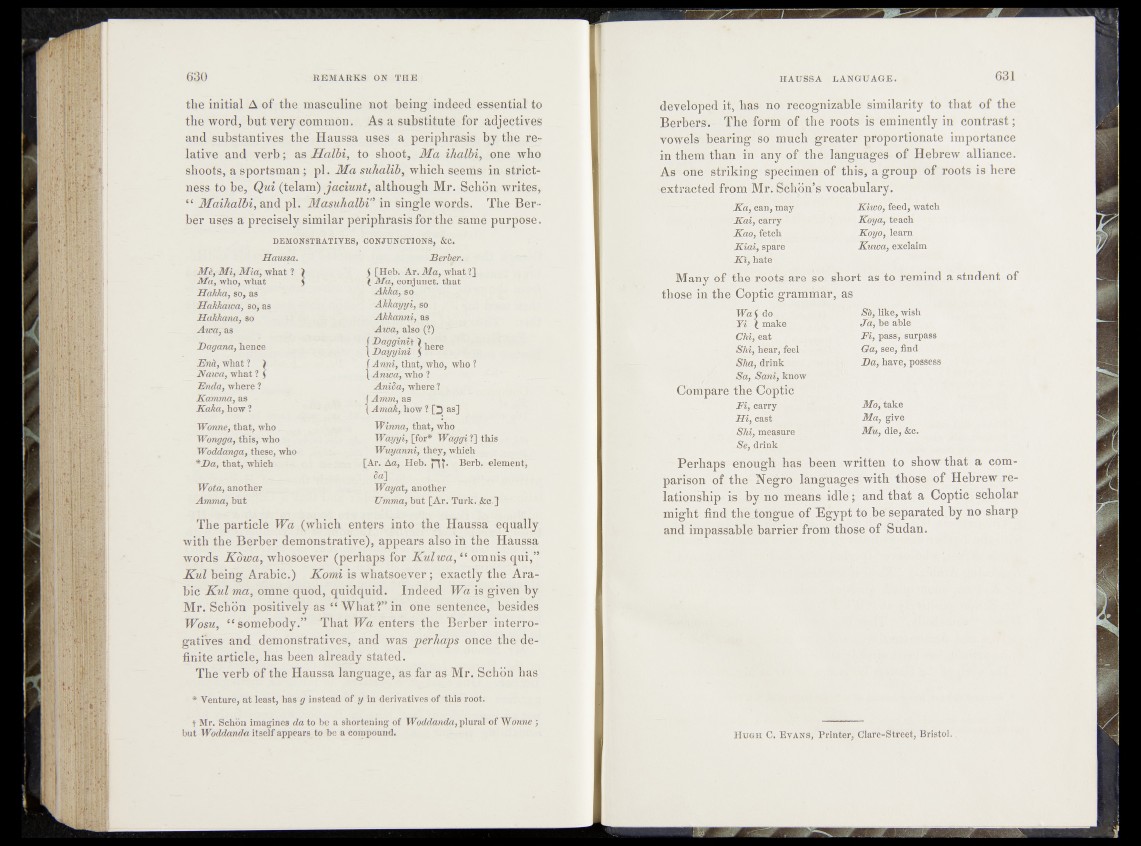
the initial A of the masculine not being indeed essential to
the word, but very common, As a substitute for adjectives
and substantives the Haussa uses a periphrasis by the relative
and verb; asJElalbi, to shoot, Ma ihalbi, one who
shoots, a sportsman; pi. Ma suhalib, which seems in strictness
to be, Qui (telam) jaciurit, although Mr. Schon writes,
“ Maifialbi, and pi. Masukalbi' in single words. The Berber
uses a precisely similar periphrasis for the same purpose.
DEMONSTRATIVES, CONJUNCTIONS, &C.
Haussa. Berber.
M$, Mi, Mia, what 1 \
Ma, who, what $
Hdkka, so, as
HaMawa, so, as
Hdkkana, so
Amu,&s
Hag ana, hence
End, what ? )
Nawa, what ? $
Enda, where 1
Komma, as
Kaka, how ?
Wonne, that, who ,
Wongga, this, who
Wodda/nga, these, who
*Ha, that, which
Wota, another
Amma, but
< [Heb. Ar. Ma, what?]..
X Ma, conjunct, that
Alika, so
Ahkayyi, so
Akkanni, as
Avia, a ls o (? )^
{s s b h ’ ƒ Awc&i that, who, who t
1 Anwa, who 1 ■.
Anida, where ?
ƒ Avftm, as
Amok, hoW I B B 1
Winna, that, who.
Wdyyi, [for* Waggi ?] this ;
Wuyanni, they, whoch
[Ar. Aa, Heb. n t - Serb. element,
fla]"
Waycti, another
UmmOf'bxit [Ar. Turk..&c.}
The particle Wa (which enters into the Haussa equally
with the Berber demonstrative), appears also m the Haussa
words Kdwa, whosoever (perhaps for Kulwa, “ omnis qui,”
Kul being Arabic.) Komi is whatsoever; exactly the Arabic
Kul ma, omne quod, quidquid. Indeed Wais given by
Mr. Schon positively as “ What?” in one sentence, besides
Wosii, “ somebody.” That Wa enters the Berber interrogative
« and, demonstratives, and was perhaps once the definite
article, has been already stated.
The verb of the Haussa language, as far as Mr. Schon has'
* Venture, at least, has g instead of y in derivatives of this root;
V Mr. Schon imagines da to be a shortening of Woddanda, plural of Wonne j
but Woddanda itself appears to be a compound.
developed it, lias no recognizable similarity to that of the
Berbers-.-- The form ofthe roots is eminently in contrast;
vowels bearing so much greater proportionate importance
in them than in any of the languages of Hebrew alliance.
As one striking specimen of this, a group of roots is here
extracted from Mr; Schpn’s vocabulary.
K a , can, may
K a i, carry
Kao, fetch
K ia i, spare
Jcîyhàte
Kiwo, feed, watch
Koya, teach
Koyo, learn
Kuwa, exclaim
Many of the roots are, so< short as to remind a student of
those in the Coptic grammar, as
WtL (d o i
■' make
Chi, eat
Shi, hear, feel
Sha, drink
Sa, Sani, know
Compare the Coptic
Fi, carry
H i, cast
Shi, measure
Se, dripk
$d,like, wish
Ja, be able
Fi, pass, surpass
Ga, see, find
Ha, have, possess
Mo, take
Ma, give
Mu, die, &c.
Perhaps enough has been written to show that a comparison
of the Negro languages with those of Hebrew relationship
is by no means idld; and that a Coptic scholar
might find theiongue of Egypt to be separated by no sharp
and impassable barrier from those of Sudan.
Hush C. Evans, Printer, Glare-Street, Bristol.